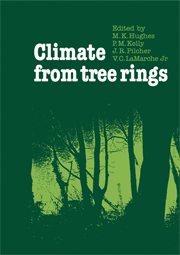4 - THE NORTHERN HEMISPHERE
Published online by Cambridge University Press: 05 October 2010
Summary
INTRODUCTION
The Editors
The distribution of land and its relief differs markedly between the two hemispheres. This influences both the potential extent of the tree-ring data base and the nature of the climatic and atmospheric circulation features that are to be reconstructed. The atmospheric circulation of the Northern Hemisphere does not have the year-round vigour of the Southern Hemisphere. Pronounced seasonal changes in climate and the strength and position of the major circulation features occur, particularly in the continental interiors. Kelly discusses climatological points of relevance to dendroclimatic analysis.
The Arctic area, reported on by Jacoby, Brubaker and Garfinkel, and Lawson and Kuivinen, is of special interest as climatic variations in high latitudes are particularly marked and may indicate changes over a much wider region. As these authors show, there has been a considerable amount of work undertaken in high latitudes, particularly in Alaska where a clear climate signal in tree rings has been demonstrated. This region has its special problems related to access to sites and the properties of the tree-ring series themselves. It is an area with great potential and one especially requiring international cooperation.
Western North America, reported on by Brubaker, is one of the most heavily worked areas of the globe. It is the source of most climate reconstructions so far. The range of species, the altitudinal gradients, and the latitudinal range have all contributed to this success, although there is much still to be done.
- Type
- Chapter
- Information
- Climate from Tree Rings , pp. 105 - 158Publisher: Cambridge University PressPrint publication year: 1982



